Abstract
Thallium tomographic imaging and exercise electrocardiography were performed on 136 diabetic patients without symptoms of heart disease. Thirty three patients had post-exercise thallium defects and 19 had ST 1 mm greater than or equal to segment depression during exercise electrocardiography. Both tests were positive in 13 patients. Coronary angiography was subsequently performed on 33 patients with either scintigraphic and/or electrocardiographic evidence of myocardial ischaemia. Angiographically significant coronary artery disease (greater than or equal to 50% narrowing of the coronary artery lumen) was detected in 13 patients. Six patients had minimal coronary artery stenosis (less than 50%), and 14 had normal coronary arteries. Six patients refused cardiac catheterisation. In 14 out of 27 patients with post-exercise thallium defects coronary angiography did not show any coronary artery stenoses (positive predictive accuracy 48%). Exercise electrocardiography showed only one false positive result (positive predictive accuracy 94%) but failed to detect coronary artery disease in three patients with a positive scintigraphic result. The accuracy of a positive exercise electrocardiographic test seems to be better than that of a positive thallium tomographic scan for detecting asymptomatic coronary artery disease in diabetic patients. The high number of false positive thallium defects may be the result of technical features inherent in thallium tomography and/or the possible disease of the small intramyocardial arteries in diabetic patients.
Full text
PDF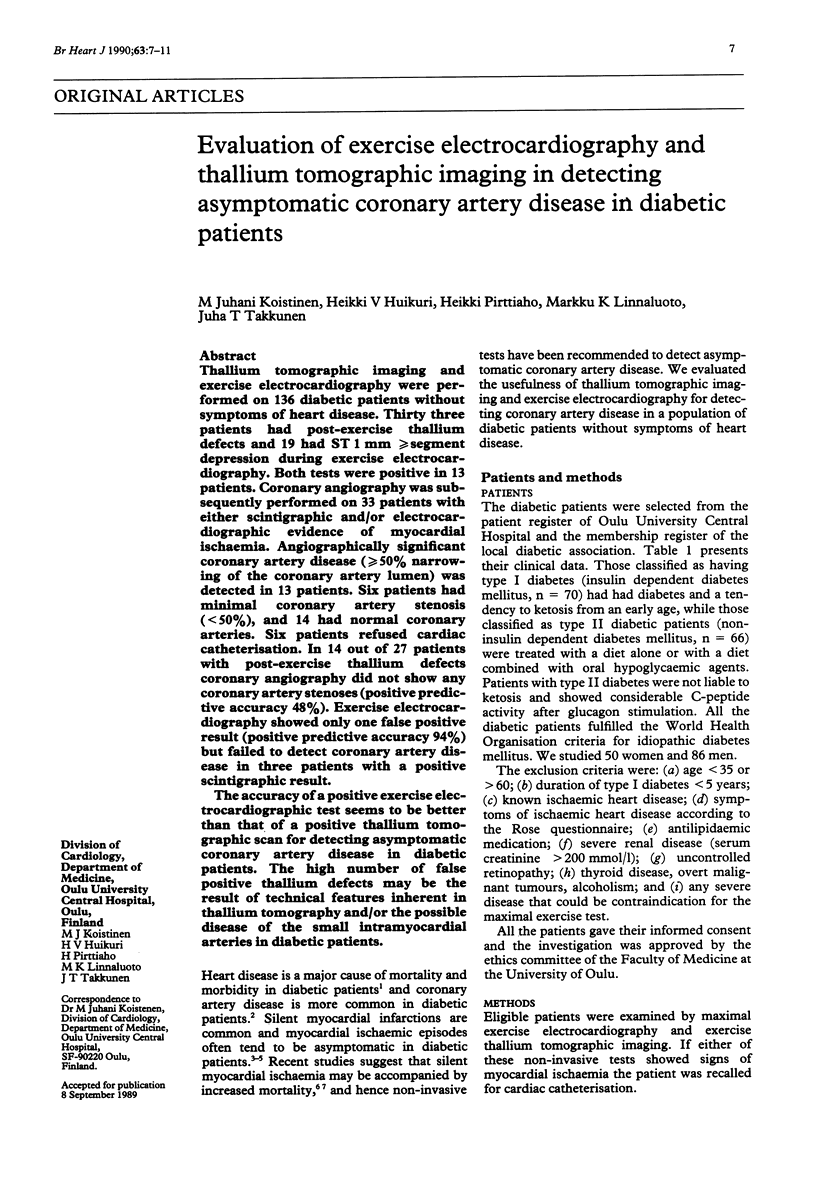
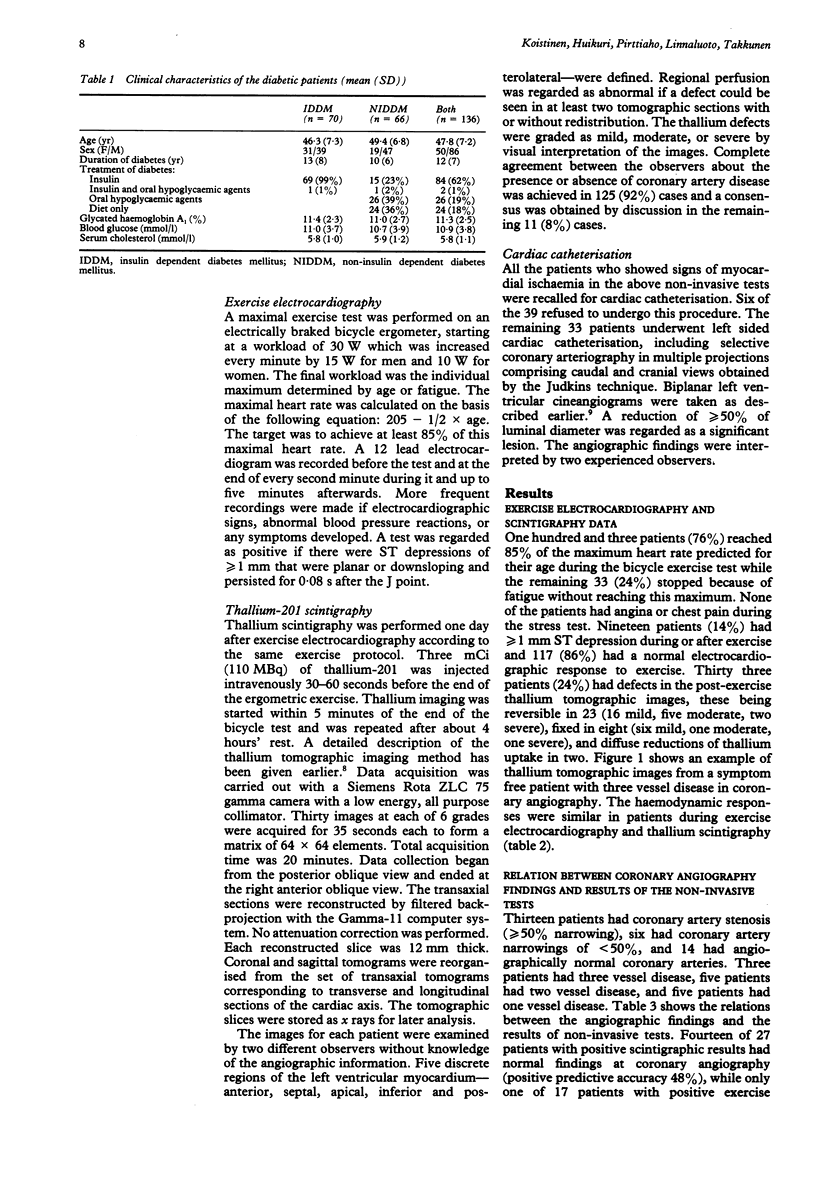
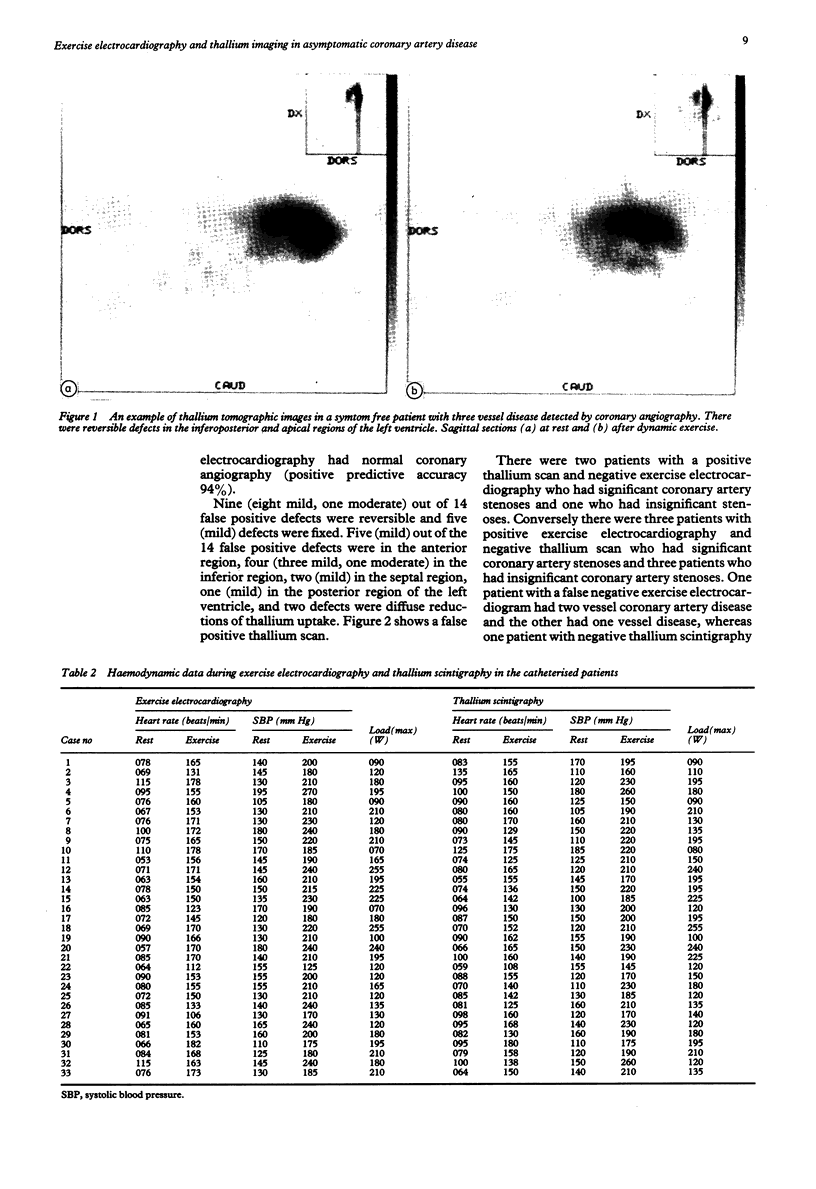
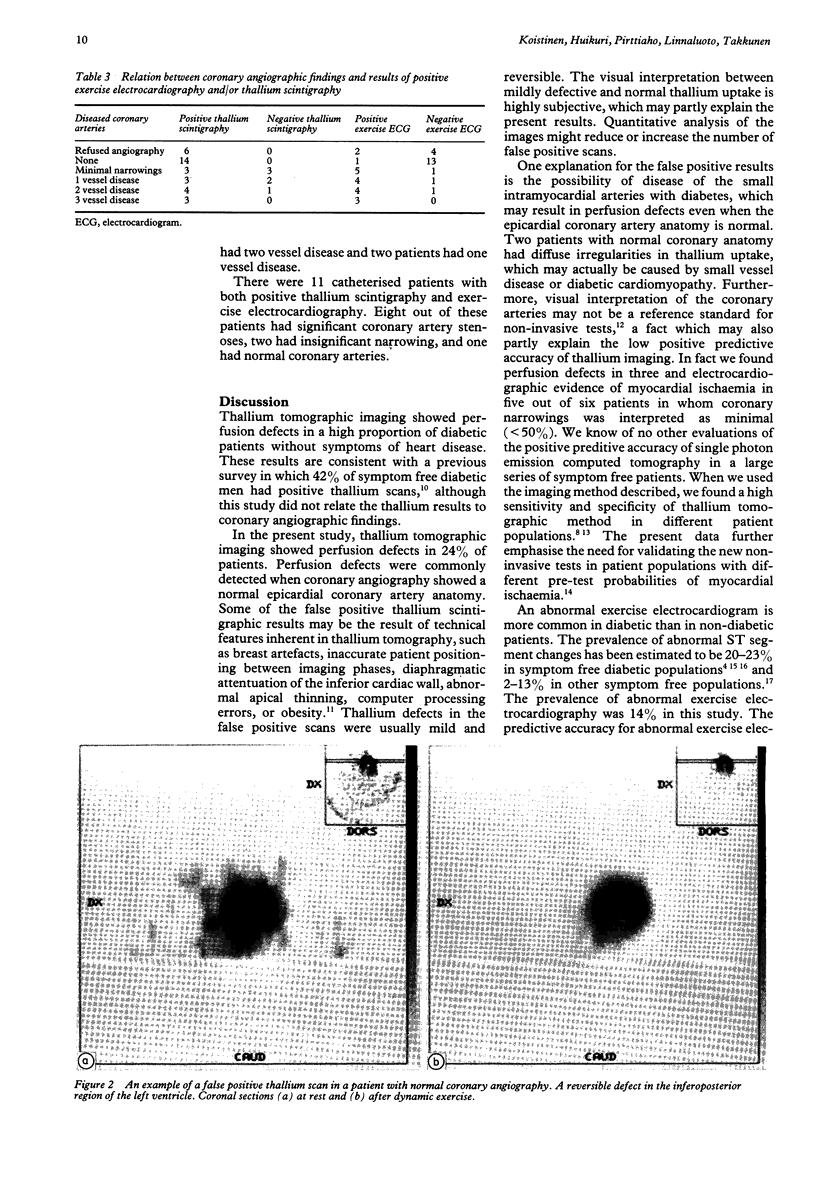
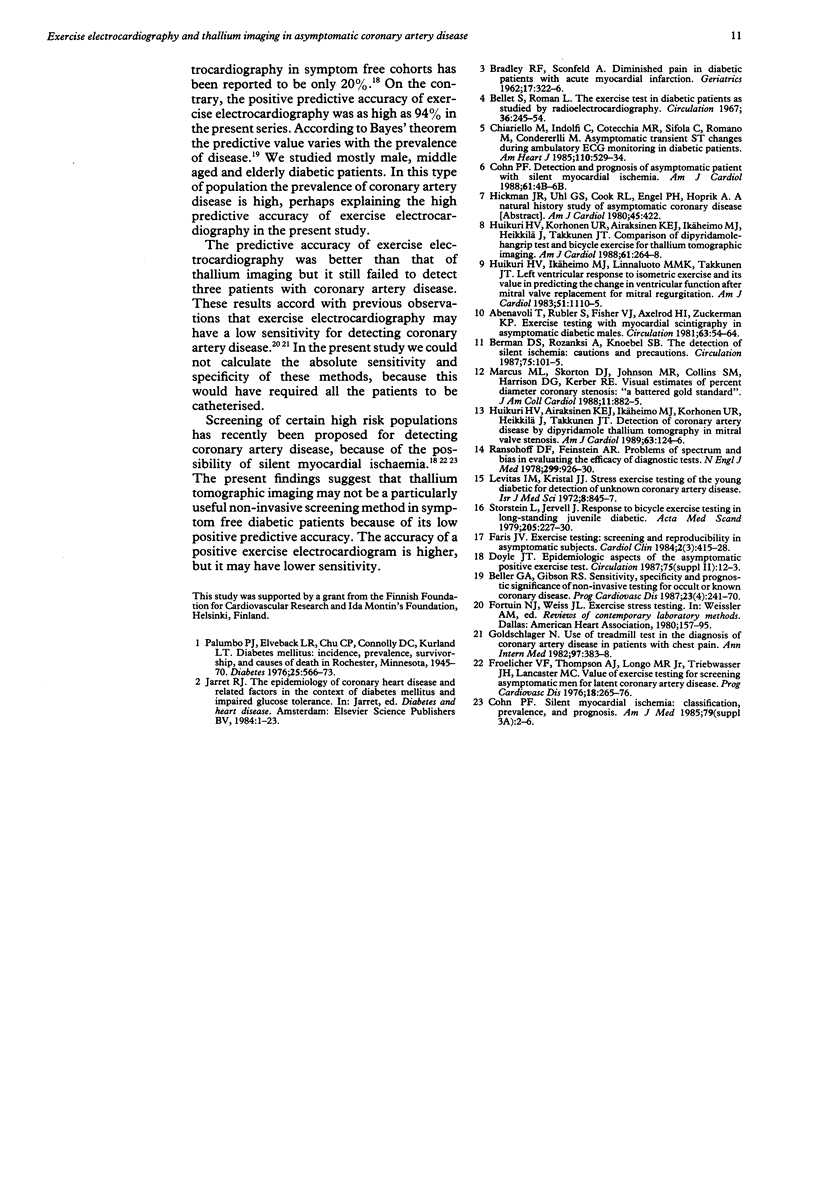
Images in this article
Selected References
These references are in PubMed. This may not be the complete list of references from this article.
- Abenavoli T., Rubler S., Fisher V. J., Axelrod H. I., Zuckerman K. P. Exercise testing with myocardial scintigraphy in asymptomatic diabetic males. Circulation. 1981 Jan;63(1):54–64. doi: 10.1161/01.cir.63.1.54. [DOI] [PubMed] [Google Scholar]
- BRADLEY R. F., SCHONFELD A. Diminished pain in diabetic patients with acute myocardial infarction. Geriatrics. 1962 May;17:322–326. [PubMed] [Google Scholar]
- Beller G. A., Gibson R. S. Sensitivity, specificity, and prognostic significance of noninvasive testing for occult or known coronary disease. Prog Cardiovasc Dis. 1987 Jan-Feb;29(4):241–270. doi: 10.1016/s0033-0620(87)80002-6. [DOI] [PubMed] [Google Scholar]
- Bellet S., Roman L. The exercise test in diabetic patients as studied by radioelectrocardiography. Circulation. 1967 Aug;36(2):245–254. doi: 10.1161/01.cir.36.2.245. [DOI] [PubMed] [Google Scholar]
- Berman D. S., Rozanski A., Knoebel S. B. The detection of silent ischemia: cautions and precautions. Circulation. 1987 Jan;75(1):101–105. doi: 10.1161/01.cir.75.1.101. [DOI] [PubMed] [Google Scholar]
- Chiariello M., Indolfi C., Cotecchia M. R., Sifola C., Romano M., Condorelli M. Asymptomatic transient ST changes during ambulatory ECG monitoring in diabetic patients. Am Heart J. 1985 Sep;110(3):529–534. doi: 10.1016/0002-8703(85)90070-5. [DOI] [PubMed] [Google Scholar]
- Cohn P. F. Silent myocardial ischemia: classification, prevalence, and prognosis. Am J Med. 1985 Sep 13;79(3A):2–6. doi: 10.1016/0002-9343(85)90486-3. [DOI] [PubMed] [Google Scholar]
- Crawford M. H., Amon K. W., Vance W. S. Exercise 2-dimensional echocardiography. Quantitation of left ventricular performance in patients with severe angina pectoris. Am J Cardiol. 1983 Jan 1;51(1):1–6. doi: 10.1016/s0002-9149(83)80002-2. [DOI] [PubMed] [Google Scholar]
- Faris J. V. Exercise testing: screening and reproducibility in asymptomatic subjects. Cardiol Clin. 1984 Aug;2(3):415–428. [PubMed] [Google Scholar]
- Froelicher V. F., Thompson A. J., Longo M. R., Jr, Triebwasser J. H., Lancaster M. C. Value of exercise testing for screening asymptomatic men for latent coronary artery disease. Prog Cardiovasc Dis. 1976 Jan-Feb;18(4):265–276. doi: 10.1016/0033-0620(76)90022-0. [DOI] [PubMed] [Google Scholar]
- Goldschlager N. Use of the treadmill test in the diagnosis of coronary artery disease in patients with chest pain. Ann Intern Med. 1982 Sep;97(3):383–388. doi: 10.7326/0003-4819-97-3-383. [DOI] [PubMed] [Google Scholar]
- Huikuri H. V., Airaksinen K. E., Ikäheimo M. J., Korhonen U. R., Heikkilä J., Takkunen J. T. Detection of coronary artery disease by dipyridamole thallium tomography in mitral valve stenosis. Am J Cardiol. 1989 Jan 1;63(1):124–126. doi: 10.1016/0002-9149(89)91096-5. [DOI] [PubMed] [Google Scholar]
- Huikuri H. V., Korhonen U. R., Airaksinen J., Ikäheimo M. J., Heikkilä J., Takkunen J. T. Comparison of dipyridamole-handgrip test and bicycle exercise test for thallium tomographic imaging. Am J Cardiol. 1988 Feb 1;61(4):264–268. doi: 10.1016/0002-9149(88)90928-9. [DOI] [PubMed] [Google Scholar]
- Levitas I. M., Kristal J. J. Stress exercise testing of the young diabetic for the detection of unknown coronary artery disease. Isr J Med Sci. 1972 Jun;8(6):845–847. [PubMed] [Google Scholar]
- Marcus M. L., Skorton D. J., Johnson M. R., Collins S. M., Harrison D. G., Kerber R. E. Visual estimates of percent diameter coronary stenosis: "a battered gold standard". J Am Coll Cardiol. 1988 Apr;11(4):882–885. doi: 10.1016/0735-1097(88)90226-4. [DOI] [PubMed] [Google Scholar]
- Palumbo P. J., Elveback L. R., Chu C. P., Connolly D. C., Kurland L. T. Diabetes mellitus: incidence, prevalence, survivorship, and causes of death in Rochester, Minnesota, 1945-1970. Diabetes. 1976 Jul;25(7):566–573. doi: 10.2337/diab.25.7.566. [DOI] [PubMed] [Google Scholar]
- Ransohoff D. F., Feinstein A. R. Problems of spectrum and bias in evaluating the efficacy of diagnostic tests. N Engl J Med. 1978 Oct 26;299(17):926–930. doi: 10.1056/NEJM197810262991705. [DOI] [PubMed] [Google Scholar]
- Storstein L., Jervell J. Response to bicycle exercise testing in long-standing juvenile diabetes. Acta Med Scand. 1979;205(3):227–230. doi: 10.1111/j.0954-6820.1979.tb06035.x. [DOI] [PubMed] [Google Scholar]




